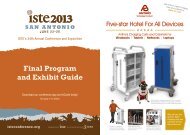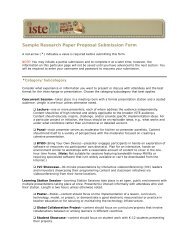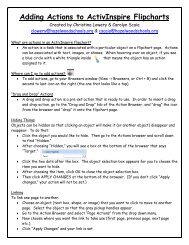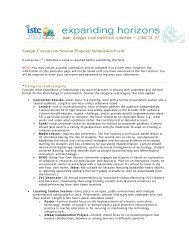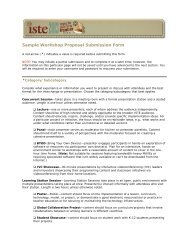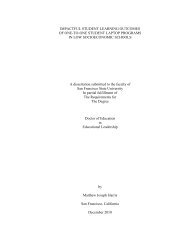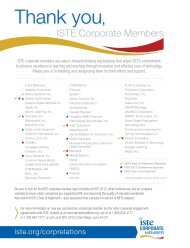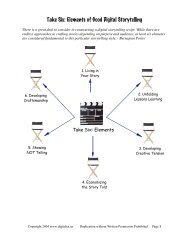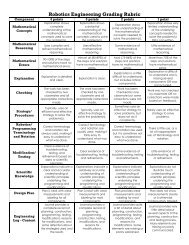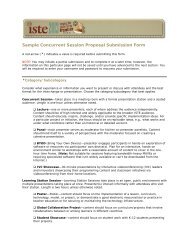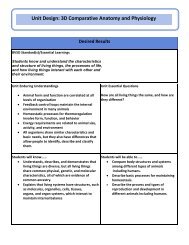Revised Bloom's Taxonomy The Cognitive Process Dimension
Revised Bloom's Taxonomy The Cognitive Process Dimension
Revised Bloom's Taxonomy The Cognitive Process Dimension
Create successful ePaper yourself
Turn your PDF publications into a flip-book with our unique Google optimized e-Paper software.
2. Understand- Construct meaning from instructional messages, including oral, written, and graphic<br />
communication<br />
2.1 Interpreting<br />
(Clarifying,<br />
Paraphrasing,<br />
Representing,<br />
Translating)<br />
2.2 Exemplifying<br />
(Illustrating,<br />
Instantiating)<br />
Changing from one form of representation<br />
(e.g., numerical) to another (e.g., verbal)<br />
(e.g., Paraphrase important speeches and<br />
documents)<br />
Finding a specific example or illustration of<br />
a concept or principle (e.g., Give examples<br />
of various artistic painting styles)<br />
Paraphrase the short story about Pablo’s trip on the ocean.<br />
Which of the following pictures illustrates corrosion of the ocean floor?<br />
2.3 Classifying<br />
(Categorizing,<br />
Subsuming)<br />
2.4 Summarizing<br />
(Abstracting,<br />
Generalizing)<br />
2.5 Inferring<br />
(Concluding,<br />
Extrapolation,<br />
Interpolating,<br />
Predicting)<br />
2.6 Comparing<br />
(Contrasting,<br />
Mapping,<br />
Matching)<br />
2.7 Explaining<br />
(Construction)<br />
Determining that something belongs to a<br />
category (e.g., Classify observed or<br />
described cases of mental disorders)<br />
Abstracting a general theme or major<br />
point(s) (e.g., Write a short summary of<br />
events portrayed on a videotape)<br />
Drawing a logical conclusion from<br />
presented information; occurs in a context<br />
that supplies an expectation of what is to be<br />
inferred (e.g., In learning a foreign<br />
language, infer grammatical principles<br />
from examples)<br />
Detecting correspondences between two<br />
ideas, objects, and the like (e.g., Compare<br />
historical events to contemporary<br />
situations)<br />
Construction a cause-and-effect model of a<br />
system (e.g., Explain the causes of<br />
Review the pictures of animals. Group them into three categories: land animals,<br />
deep ocean animals, shallow ocean animals.<br />
Click on the link about Seals and Walruses. Summarize the paragraph titled,<br />
“What are pinnipeds?”<br />
Describe the principle of hot water and cold water movement in the ocean. How<br />
does it affect the ocean and land?<br />
• Compare each of the following ocean-related terms and tell how they are<br />
related: continental slope, currents, tides, ocean floor, coast, waves, swells<br />
and salinity. Use http://creately.com/Draw-Venn-Diagrams-Online to create<br />
Venn Diagrams online.<br />
• Compare/contrast an ocean with a lake, a sea and a river. Use a Venn<br />
Diagram to help you record the similarities and differences.<br />
• Explain the causes of a tsunami.<br />
• Explain how waves are formed.



